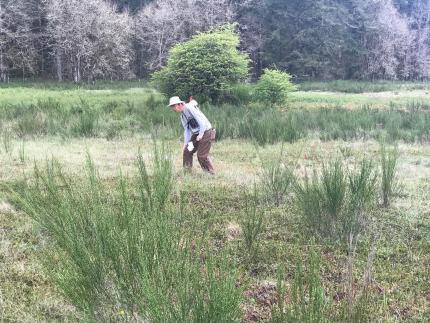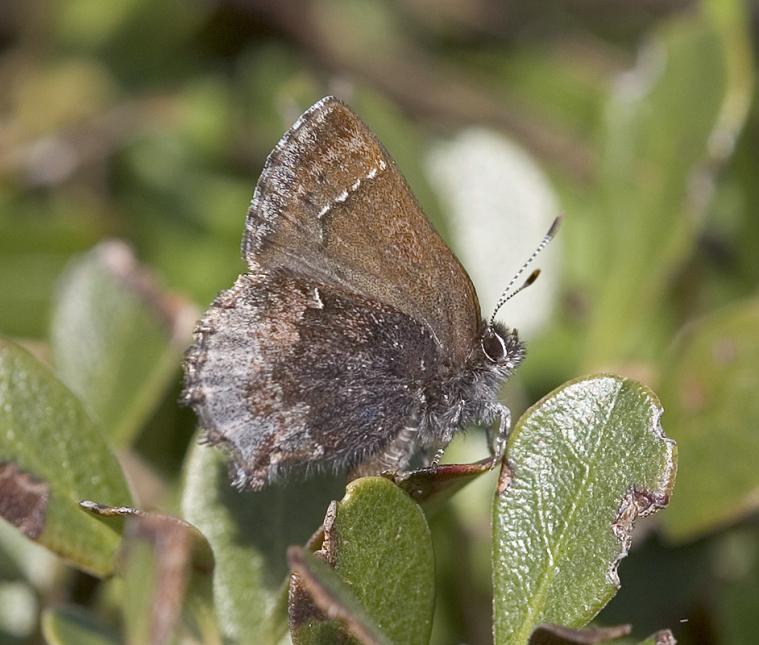Low-
Moderate
The population of the hoary elfin (Puget Trough segregate) is critical and is considered to have a declining trend. This lycaenid butterfly species is recognized as a state "Species of Greatest Conservation Need" due to its rare and restricted hostplants [food for caterpillars (larvae)] and habitat types, small number of isolated populations, highly limited range and distribution, and threats to its habitat. Research is needed on this species to understand its life history and quantify specific habitat requirements including vegetation structure, food plant size and density, and key habitat features.
Description and Range
Physical description
The Lycaenidae butterfly family consists of small and often brightly colored species with the common names: copper, hairstreak, elfin, and blue. The hoary elfin is less than 1 inch in size. It is brownish with a row of white dashes on the underside of its fore wing and has frost-like (hoary) markings on the underside of its hind wing.
Ecology and life history
The hostplant of the hoary elfin (Puget Trough segregate) is kinnikinnick (Arctostaphylos uva-ursi), a short, prostrate, evergreen woody shrub, relatively common at most elevations in western Washington; however, the butterfly occurs only at low elevations on glacial outwash prairies and forest opening balds in the south Puget Sound region and early successional scrub-heath habitats (including forest clearings) on the Kitsap Peninsula. Hoary elfin habitat across all regions is open or located at forest edge.
This lycaenid butterfly completes a single life cycle annually (univoltine). All lycaenids are sedentary butterflies and do not migrate; instead, the species inhabits sites year-round (as egg, larva, pupa and adult), typically moving within only a few hundred yards of their natal locations. Adults emerge from their chrysalids (pupae) during species-specific time periods; the hoary elfin’s adult period is April through May.
Both males and females feed by using their long proboscis to sip floral nectar. Males of most species require salts, which they obtain from evaporated puddles and moist soil and animal urine and feces.
Larvae are slug-like in appearance and highly camouflaged in their host species. Many lycaenid larvae engage in mutualistic relationships with ants, known as myrmecophily, which typically consists of ants tending and milking larvae, obtaining nutrition in the form of a nectar-like substance (honeydew) in the process, and also protecting larvae from predators and parasitoids; in some situations, the ants move butterfly larvae or pupae into ground chambers, including their nests. The overwintering stage varies by lycaenid species: hoary elfin overwinter as pupae.
Geographic range
The distribution of the hoary elfin (Puget Trough segregate) is limited in part by a combination of its dependence on rare hostplant occurrence within rare habitat types. In Washington, its distribution and abundance in Washington is characterized by small numbers of small, isolated populations. The species' overall range is in South Puget Sound regions; occurrence has been documented in Kitsap, Mason, Pierce, and Thurston counties.
For a range-wide map of distribution and conservation status of hoary elfin, check out NatureServe Explorer.
Climate vulnerability
Sensitivity to climate change
Low-
Moderate
There is no information regarding the physiological sensitivity of this species to climate change, but it may be limited by temperature, as it currently appears only in lower elevation areas of Washington, even though its host plant exists at higher elevations. Hoary elfin is likely sensitive to climate-driven changes in its larval host plant, kinnikinnick. Kinnikinnick is resilient to dry conditions. Fire maintains the open, high sunlight environments preferred by kinnikinnick and occupied by the hoary elfin (e.g., prairies, forest opening balds), but kinnikinnick may be sensitive to increasing fire frequencies and severities, as it appears to be adapted to low severity fire and to exhibit moderate survival and recovery post-fire.
Exposure to climate change
Low-
Moderate
- Altered fire regimes
Conservation
Conservation Threats and Actions Needed

- Resource information collection needs
- Threat: Knowledge of current distribution is incomplete
- Action Needed: Conduct surveys to determine current status and distribution of populations, especially needed on the Kitsap Peninsula
- Fish and wildlife habitat loss or degradation
- Threat: Development destroying prairie habitat, including highway building
- Actions Needed: Species and habitat management plans for occupied sites; purchase and protect prairie sites
- Invasive and other problematic species
- Threat: Invasive plants, those currently here, and many yet to come in the future, out-compete native grassland species, and otherwise make habitat unsuitable
- Actions Needed: Using herbicide, fire, and mechanical methods to restore native prairie; planting/seeding native prairie species
See the Climate vulnerability section for information about the threats posed by climate change to this species.
Resources
References
Ballmer, G. and G. Pratt. 1991. Quantification of ant attendance (Myrmecophily) of lycaenid larvae. Journal of Research on the Lepidoptera. 30(1-2): 95-112.
Hays, D., A. Potter, C. Thompson, and P. Dunn. 2000. Critical habitat components for four rare south Puget Sound butterflies. Final report to The Nature Conservancy. Washington Department of Fish and Wildlife. Olympia.
James, D. and D. Nunnallee. 2011. Life Histories of Cascadia Butterflies. Oregon State University Press, Corvallis. 447 pp.
LaBar, C. C. 2009. Investigating the use of herbicides to control invasive grasses in prairie habitats: effects of non-target butterflies. M.S. Thesis, Washington State University, Vancouver. 37pp.
Pyle, R.M. and C.C. LaBar. 2018. Butterflies of the Pacific Northwest. Timber Press. 461 pp.
Pyle, R. 1989. Washington butterfly conservation status report and plan. Washington Department of Fish and Wildlife, Olympia. 216pp.
WDFW publications
Other resources
- A Region Specific Guide to Butterflies of South Puget Sound, Washington (R. Gilbert & A. Potter 2014)
- Xerces Society - Butterfly Conservation
